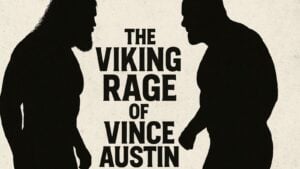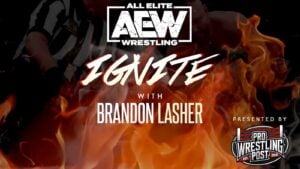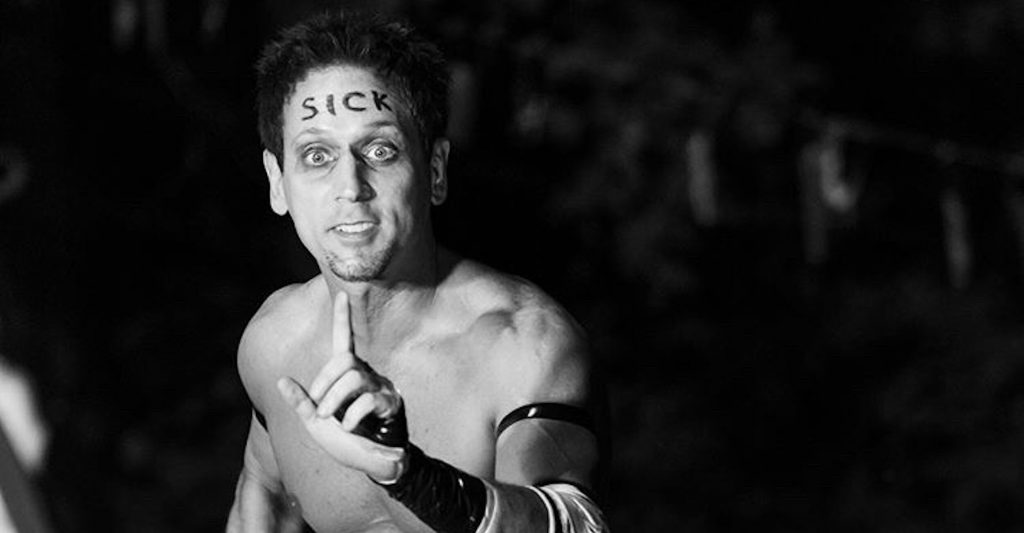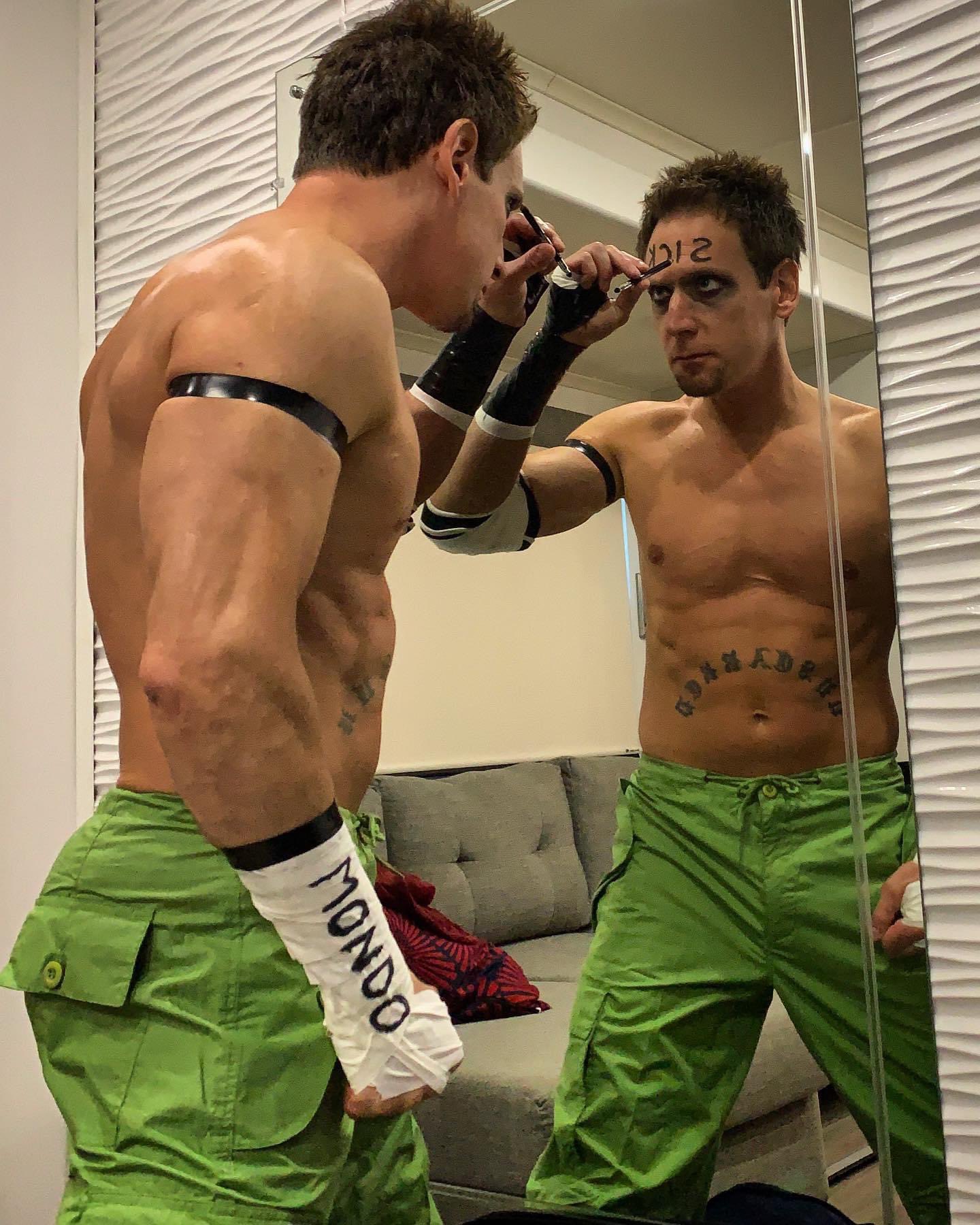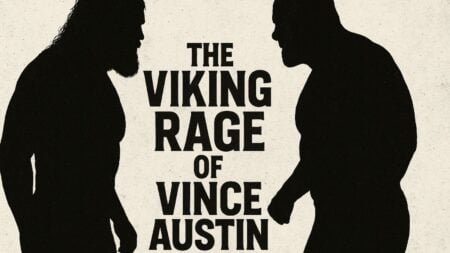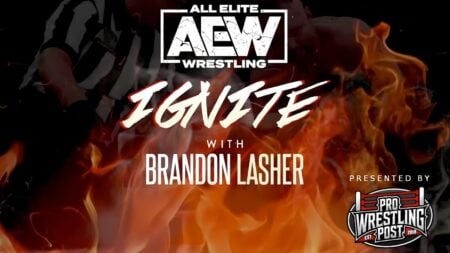Take your mind back to the mid-90s for a moment. What were you doing? Perhaps you were watching MTV’s Beavis and Butthead on an old crappy CRT-TV screen.
Maybe you were perfecting “fatality” combos for Mortal Kombat 3 against your buddies on that new “Playstation” console.
Or were you watching Terry Funk and Tommy Dreamer face off against Raven and Cactus Jack at ECW November To Remember? For Matt Burns, the latter of the three possibilities was most relevant to his adolescent years.
When Burns was 16 years old, he and his friends began “backyard wrestling.” At least, that’s what it was in retrospect.
By 1996, backyard wrestling hadn’t taken off in the United States in the way that it had in the early 2000s. To Burns and his friends, they were just fooling around and play-fighting.
They called these fights “ninja battles,” and would sport goofy outfits, throw punches, kicks, and any environmental assistance they could get their hands on, for the sole purpose of entertaining that testosterone-fueled, hyperactive teenage-boy brain.
“At the time, the whole backyard wrestling craze hadn’t even hit the country,”
Burns said. Yet, as is to be demonstrated by the future trajectory of Burns’ career as a professional wrestler, he was always a trailblazer.
Spears and powerbombs were often juxtaposed with barbed wire, steel chairs, and wooden planks in these “ninja battles,” and as much as Burns was only having fun, he was also laying the foundation for what his legacy in the eyes of his fans would be.
When Burns graduated from high school, he found himself on the path to joining The US Marines, yet after going through the sign-up process and even being sworn in, he had a sudden change of heart.
Not only did he not want to go off to war for obvious reasons, but being as impassioned with Extreme Championship Wrestling and the hardcore wrestling scene as he was from a fan’s perspective, he wanted to live out his dream of emulating his heroes on TV.
With The Marines prospect now out of the picture, a young Burns, straight out of high school, worked for a concrete company and eventually saved up enough money to enroll in wrestling school and get trained.
On January 2nd, 1999, Burns started training at an Ohio wrestling school that he referred to as a
“really beat up dirty warehouse building,” “But we didn’t care,”
he said
“cause we were there to train.”
Immediately after his 10-week training period, Burns began wrestling for the Cleveland independent scene.
It’s in these promotions that Burns found his surefire connection with wrestling audiences.
“I realized that I still had a lot to learn […], but somehow I always seemed to leave fans happy with my matches,”
Burns said.
Despite being a new independent professional wrestler, the Cleveland Indies allowed Burns to showcase his very evident athleticism, pronounced charisma, and exceptional technical in-ring skills.

During his ring entrance in PCW, Burns was announced as “Hardcore” Nick Mondo and would enter through the curtains holding a cookie sheet that would eventually be used as a weapon in his subsequent matches, either unto his opponent, but most often unto himself at the hands of his adversary.
The concept of hardcore wrestling in the US had already been going through a renaissance at this point thanks to the likes of WWE and WCW’s respective hardcore divisions, Paul Heyman’s Extreme Championship Wrestling and Ian Rotten’s IWA: Mid-South.
Mondo’s gimmick, therefore, was contemporary, exciting, and fitting for a man of already such high regard to his fans in the Cleveland and Pennsylvania independents.
During Mondo’s later years in PCW, he began feuding with Eddie Valentine. The two would go on to have outstanding, technical, high-flying, and often hardcore matches against one another.
Their feud culminated in a “Singapore Cane Match,” where a Singapore cane was suspended on a pole above one of the ring’s turnbuckles, and the first person to grab hold of it was allowed to use the item as a weapon against their opponent.
Predictably, these matches often end up with both participants using the cane as a weapon, as it is essentially a no-DQ match. With this in mind, Mondo’s and Valentine’s Singapore Cane match at PCW’s “Pennsylvania Maynia” was a violent, bloody battle that would go on to foreshadow the direction of Burns’ in-ring career
Per the match’s stipulation, the loser of the bout would have to receive 10 lashings from the cane courtesy of the winner.
“I had told Eddie, ‘don’t hold back on the cane shots,'”
Mondo recalled. And so, Mondo received 10 lashings to the back courtesy of Valentine.
“It was, at the time, the most painful thing that I had taken in wrestling.”
If only Mondo would be able to look a couple of years into the future to see how tame this moment was relative to what his body would endure later on.
The match was particularly impressive from a fan’s point of view, featuring a number of high spots, including a top rope facebuster onto a steel chair and a huge backdrop over the top rope onto a table at ringside.
During his first few months with the promotion, Mondo was flying out to CZW shows from his new home in Minnesota, yet eventually, as he slowly became a fan favorite and an unquestionable acquisition, the company began flying him out to the shows on their dollar.
“Things really seemed to be going good for me for a while, but 2001 was actually a pretty dark period for me. I guess it started with the fact that I didn’t have a lot of […] the friends that I grew up with.
But wrestling also was at kind of a dull point for me… And I made the mistake of deciding to get involved in violent matches.”
In only his first three months in 2001 in CZW, Mondo wrestled in a three-way ladder match, a barbed wire ladder match, and a “fans bring weapons” match, all of which were indicative of the legacy that Mondo was slowly building on the hardcore independent scene.
The early 2000s hardcore promotions such as CZW and IWA: Mid-South were already becoming synonymous with cringe-inducing and painful-looking spots, only seen prior in slasher films from the 1980s.
Light tubes, thumbtacks, glass panes, barbed wire, and gallons of hard-way blood were all becoming tantamount with these promotions and, consequently their wrestlers too. Thanks to the violent matches he was participating in, Mondo’s popularity on the independents was soaring.
Alongside competing in IWA: Mid South’s King of the Deathmatches tournament, Mondo also found himself in some of CZW’s most “ultraviolent” bouts against some of the promotion’s most seasoned violence artists.
“I was just really kind of struggling with the whole depression thing, and I did a match where they actually took the ropes down from around the ring and put barbed wire in its place,”
Mondo remembered.
At CZW’s “Who’s The Boss” event in 2001, Nick Mondo went one-on-one with fellow deathmatch legend Nick Gage in a no ropes barbed wire deathmatch.
“… to me, looking back, that match just really kind of epitomizes my depression,”
Mondo said.
Near the end of the match, both men were bleeding profusely before Mondo hit his patented Assault Driver onto Gage through a flaming table covered in light tubes. It was as emotionally visceral to watch as it was physically. With Mondo’s mental health in mind, the match was as poetic as it was violent.
Thankfully by 2002, Mondo’s mental health had taken a turn in the right direction as a girlfriend, as well as projects outside of wrestling, including art and filmmaking, were filling parts of his life that he was seeking fulfillment in.
During this year, a dream match to hardcore wrestling fans would finally take place in CZW when The Messiah of Xtreme Pro Wrestling fame stepped foot into Mondo’s territory, and the two would put on an absolute classic.
The crowd was thoroughly behind both men as nobody in attendance at the Viking Hall arena that night left their feet. As expected by two of the early 2000s’ most unsung heroes of independent wrestling, stiff shots, awe-inspiring high-flying, hardcore spots involving chairs and trash cans, table bumps, and plenty of “SOMEONE CALL 911” action were all apparent.
The chemistry between Mondo and The Messiah was indisputable, and both men managed to showcase what independent wrestling brought to the table and why it was a medium worth consuming.
On August 31, 2002, Combat Zone Wrestling hosted their first-ever “Ultraviolent Tournament of Death,” a deathmatch tournament that would eventually become one of the promotion’s staples in the coming years. The Ultraviolent Tournament of Death, as is implied by its name, saw participants wrestle in continuous deathmatches throughout the night until a tournament winner was crowned.
Sick Nick Mondo – The Ultraviolent Superhero
It’s at this first tournament that “Sick” Nick Mondo began the cementing process of his legacy as one of the most memorable and beloved deathmatch wrestlers of all time.
His first-round match against Homeless Jimmy saw not only the unbelievable acrobatics that fans were expecting from Mondo but his knack for dishing out and taking unadulterated violence onto his and his opponents’ bodies through the use of weaponry.
The ending of this match famously saw both men on the top of a 20-foot Ryder truck above a “log cabin” of light tubes placed on top of some stacked up tables. Mondo delivered an Assault Driver onto Jimmy off of the truck through all of the armament below, as CZW’s signature air horns sounded and the fans collectively lost their minds. From that point on, Mondo was the favorite. Mondo was CZW.
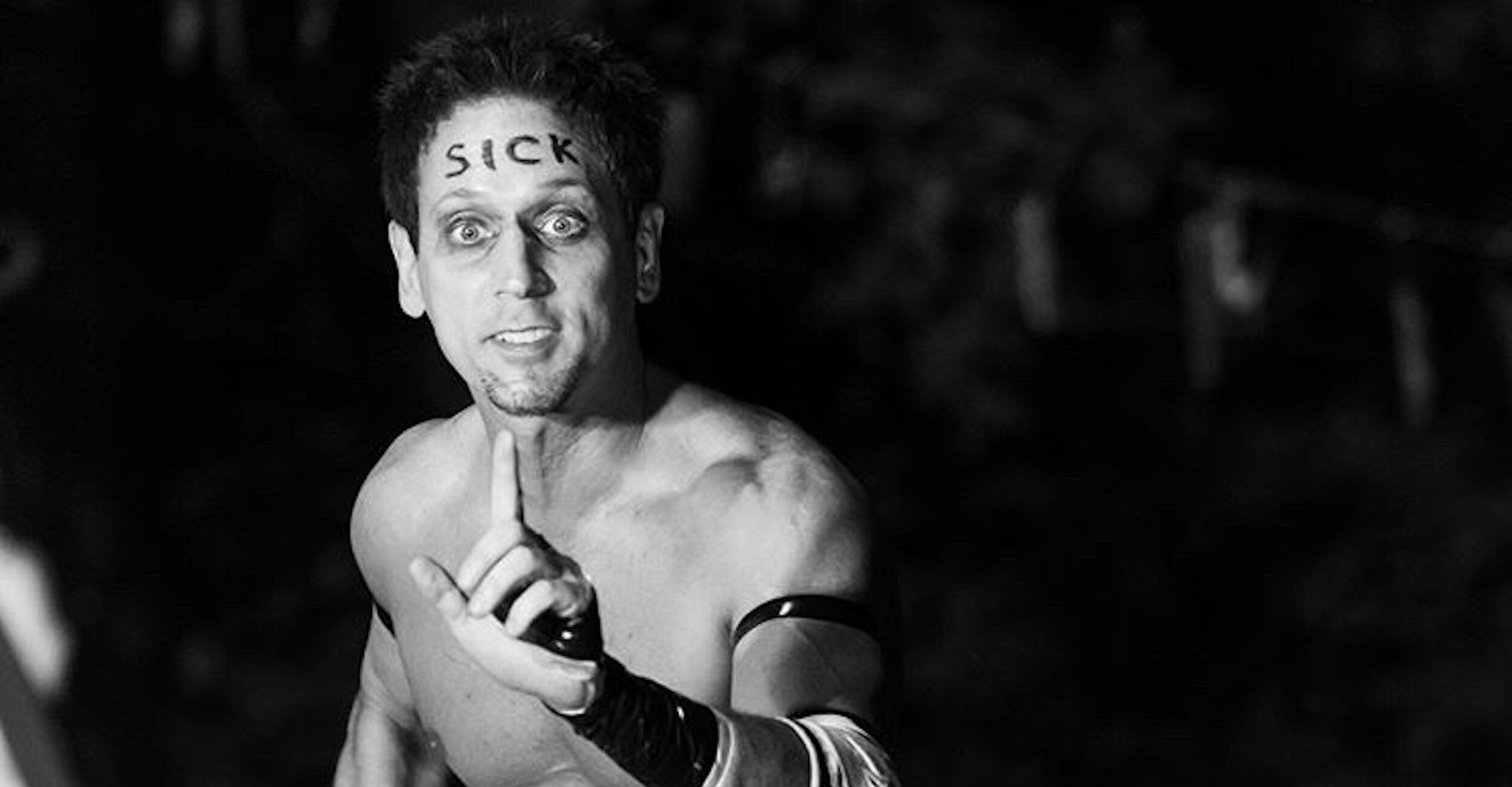
While the commentators called Mondo a “son-of-a-b**ch,” the fans ate it up. Mondo had proven to fans that he was as hardcore and ultraviolent as hardcore and ultraviolence got.
Mondo’s third-round match saw him against another CZW legend, Wifebeater, in a 200-light tube deathmatch that saw the perimeter of the ring covered in vertical standing light tubes. Immediately, as the match started, Wifebeater missed a spear attempt and went headfirst into a bundle of light tubes at the corner turnbuckle, as Mondo quickly followed up by disintegrating another light tube over the fallen Wifebeater’s head.
At one particularly brutal portion of the match, a heavily bloodied Mondo lay prone as Wifebeater obtained a bucket of salt and poured it all over the open wounds on Mondo’s back.
The ending of this match saw perhaps one of the most famous spots in the history of deathmatch wrestling.
“I wanted to send fans home happy and also shocked,”
Mondo said.
“I mean, they had seen a whole night of violence, so I was like ‘you know, how am I gonna top everything that happened that night?'”
Wifebeater pulled out a weed-whacker as the night sky blackened the two men’s surroundings. Only the artificial light of nearby buildings and flashes from the cameras at ringside illuminated the bloodied canvas covered in broken glass, salt, and the remains of 200 light tubes.
Wifebeater swiftly moved the powered-on string trimmer to Mondo’s silhouette as blood sprayed off of his torso like a crimson mist. It was a surreal ending to a surreal night of brutality.
“… and so I took the weed-whacker to the stomach,”
Mondo recalled.
“And much against the will of a lot of the other people in the locker room. They were telling me I shouldn’t do it. It was the most painful thing I’ve ever been through, but it was well worth it just for all the recognition it gave CZW… It was just a perfect ending to a shocking night.”
By the end of 2002, thanks in part to the Tournament of Death but also incredible matches that year against the likes of Trent Acid, Johnny Kashmere, “Spyder” Nate Webb, and Colt Cabana, Mondo’s popularity was at heights he had never imagined.
“Sick” Nick Mondo
To this day, a corkscrew leg-drop from the top rope is often referred to as a “Mondo Sledge,” and an Assault Driver is well… an Assault Driver! Mondo’s very own modification of a standard Electric Chair Driver has been given its own title, thanks to the creativity of the man behind the move. When an arsenal is not only attributed to but directly named after a performer, that person’s influence is undeniable
His moves, alongside his signature spiky hair, baggy pants, mannerisms, and “Sick” face paint all made Mondo not only another professional wrestler but a character come to life. Superman and Spiderman were reserved for the paperback, but “Sick” Nick Mondo was the real thing.
Nothing was cooler than this larger-than-life character, with an array of these video game-esque moves in his back pocket, who was willing to put his body through unimaginable lengths for the sole entertainment of his fans.

“I took all the things that I would like to see as a fan from a wrestler and incorporated them into my character,”
Mondo said.
“I mixed in every style of wrestling. I mixed in high-flying with high spots, technical wrestling, and of course, big bumps, which is what my character was known for & I combined them all into one package, and it really helped me excel and made 2002 the best year of my entire wrestling career.”
As any professional wrestler will tell you, injuries, pain, and rehabilitation, all come with the territory. It’s difficult to avoid getting hurt in such a high-risk performance. That’s why when you take into account the style of wrestling Mondo was competing in, those risks were only amplified.
Deathmatch wrestling is, by its very nature, a high-risk medium. Yet, that’s what makes it so entertaining. It’s the spectacle of these men and women enduring and supplying inconceivable bodily harm for us, the fans, that keeps us coming back to cheer for our heroes.
By 2003, the consequences of Mondo’s matches were catching up to him. A series of back and neck injuries, exacerbated by a nasty-looking chair shot in a match against Nate Hatred and Zandig, and later a car accident in Italy acted as “warning signs” to Mondo that his in-ring career needed to come to an end.
It wouldn’t take long for these warning signs to come to fruition in the form of one final Ultraviolent Tournament of Death.
CZW’s second annual Ultraviolent Tournament of Death saw Nick Mondo in a first-round match against the late JC Bailey. Mondo came out to the ring wearing a cast on his arm, as just three weeks earlier, he had injured his right wrist.
Through his sheer dedication to giving the fans what they wanted, Mondo decided to compete in the deathmatch tournament with three broken bones. Despite being a phenomenal match, it’s Mondo’s second-round bout against Zandig that is host to perhaps the most famous (or infamous) spot in all of Deathmatch wrestling history.
The two men competed in a Two Out Of Three Light Tube Log Cabins match that saw plenty of ordnance utilized by both men before one ultimate bump that made its way through internet wrestling forums and file-sharing software for years to come.
Zandig had decided that the ante of Mondo’s Ryder truck bump from the previous year’s tournament needed to be upped. The two men made their way up to the roof of the two-story building that they were performing outside of. Zandig would hoist an upside-down Mondo over his shoulder in a fireman’s carry-like position.
The two men would be airborne for a solid couple of seconds before landing on a contraption of tables and light-tube log cabins on the concrete below, followed by a nearly 30-second “holy s**t” chant from the fans in attendance.
Only, Mondo’s fall wasn’t broken by the debris. Instead, the fall was overshot, and Mondo essentially landed back-first directly onto the concrete as Zandig’s feet broke the top-stacked table and the light tubes on top, while the back of his head hit one of the remaining-intact tables, knocking him unconscious.

“I hit the ground, and I’ve never been that rattled in my entire career. I remember just laying there, and for a while, I couldn’t even move my limbs,”
Mondo recalled.
Mondo had punctured an artery in his back while landing on the concrete, and the wounds of that injury were evident, as when he finally did get up, his back was an opaque dark red.
“It was difficult for me to talk, and I was just laying there, wondering if I was even gonna be able to get back up,”
He grimly remembered.
He did get up, however, and by some wrestling miracle, he did not only finish the match but finished (and won) the entire tournament.
“The nurses in the back didn’t want to let me continue because I was bleeding so profusely, but I insisted on finishing the tournament that night,”
He said.
Despite being what he called “barely conscious,” Mondo wrestled and won the tournament’s final match against Ian Rotten, who had helped to carry the heavily injured Mondo to a solid match and a triumphant victory.
As Mondo held his trophy in the air, a defeated Ian Rotten grabbed the microphone and said,
“You come in here and wrestle with a broken wrist & You come into this finals with a big puncture in your back. You are always, and always will be, what extreme wrestling, hardcore wrestling, and ultraviolent wrestling is meant to be.”
And so, with a whole fan base thoroughly behind him, the Ultraviolent Tournament of Death trophy, and the hardcore wrestling world’s eyes on him, “Sick” Nick Mondo, the Iron Man Champion, decided to call it quits.
After watching back the footage and recovering from his injuries, Mondo decided that there was no better time to retire from in-ring action “and say ‘that’s enough.'”
“I’ve had fans say that I’m indestructible or I’m a superhero, which is incredibly flattering to me,”
Mondo said.
“…as a youngster, when I would watch all the cartoons and the movies and stuff, I really did want to be seen in people’s eyes as a superhero. And so, in a way, that was really accomplishing that goal for me.”
In 2004, Midway Studios Los Angeles, (f.k.a Paradox Development) developed a sequel for Backyard Wrestling: Don’t Try This At Home, titled Backyard Wrestling 2: There Goes The Neighborhood.” The games were standard 3D fighting titles with a heavy focus on interactive environments and the use of weapons.
The games very clearly took influence from the hardcore wrestling scene of the early 2000s, featuring roster members like the Insane Clown Posse, Ruckus, Zandig, and of course, “Sick” Nick Mondo.
“One of my dreams as a wrestler was to one day see my character in a video game,”
Mondo said.
“Seeing that come to life, you know, my character in a game… was unbelievable. It was such a blessing just to see my dream come true…”
Despite a relatively short career, “Sick” Nick Mondo was able to demonstrate physical and emotional perseverance in and outside of the ring like few others are able to replicate. That’s why Deathmatch and hardcore wrestling will always be synonymous with his name and image.
The word “legend” gets thrown around a lot in the media, especially when it comes to those whose careers were cut short. Yet, when it comes to Mondo, a professional wrestler who was able to revolutionize and inspire a whole generation of fans and wrestlers alike while living out his childhood dreams, that title is more than earned.
At Cage of Death XV on December 14, 2013, Nick Mondo made a surprise appearance to CZW, much to the shock and elation of the fans at ringside, in order to help The Nation of Intoxication defeat The Forgotten Ones in a Cage of Death Match. Since then, he has made two separate appearances for Brian Kendrick’s Wrestling Pro Wrestling promotion under the name Pepperoni Tony.
For nearly 20 years, Mondo has been a mainstay in the stunt and filmmaking industry. In 2004, he wrote and directed his own documentary titled Unscarred: The Life of Nick Mondo. He has also performed stunts for a number of TV shows and movies, including Starz’s hit Heels, and even created video packages for All Elite Wrestling and Game Changer Wrestling.
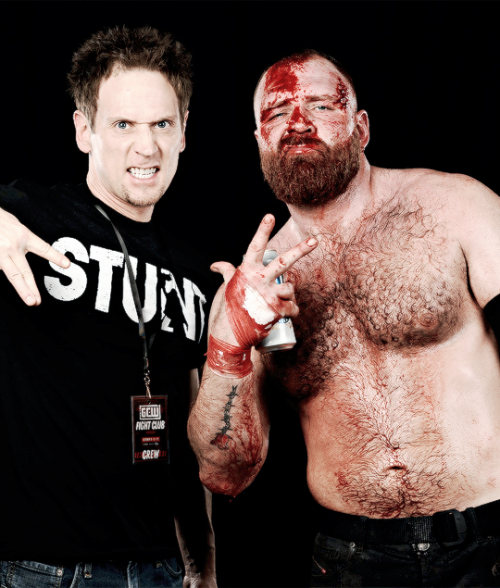
To this day, fans typically can’t hear Papa Roach’s “Last Resort” without the visuals of a baggy pants-wearing, spiky-hair-donning Nick Mondo entering through the CZW curtains with his elbows raised 90 degrees. For there are few greater wrestling memories for some than to see the hardcore hero, “Sick” Nick Mondo, deliver an M. Bison onto the back of some poor dude’s head.
All quotes in this article are taken from the documentary “Unscarred: The Life of Nick Mondo.”
